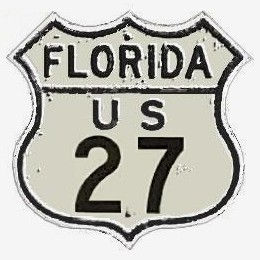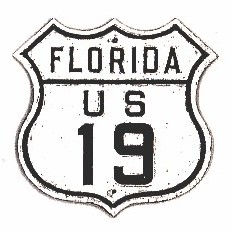Driving back to the farm last night in the wind and rain that remained of Hurricane Sally, it occurred to me that one way to get to know a place is to look at the roads leading there, the history of those routes, and how the traffic and the travelers might have shaped the community where we live and raise chickens.
Perry, before the advent of the interstate, was something of a crossroads for travelers in this part of the country. It still is, although the flow is a lot lighter with the interstate an hour or so to the north and to the east.

And as the old U.S. highways converged here in the 1930s, they comprised one jumble of designations for miles in either direction. When I drive to Chiefland, I can travel down Alt 27, Highway 19, and Highway 98 all at the same time.

It reminds me of quantum physics, and has me wondering if, like an electron, I am actually on three different roads until someone observes my old Dodge lumbering down the highway.
There are four different federal highways that run through here, arteries leading into different parts of the country with different cultures and stories, that all converge in this swampy plain.
Running north and south is U.S. 27, which used to begin way up in Michigan during the Depression, but now ends in Indiana somewhere.

Over the years, U.S. 27 was the road workers from the industrial north drove to vacation or retire in the Sunshine State. To this day, these woods are dotted with trailers and little houses whose occupants bear witness to tough lives working on shop floors and shoveling snow, delivered in a nasally accent that startles here in this deepest corner of the South. One would be hard-pressed to find grits in their cupboard, and if so they'd probably be instant.
Highway 27 was also the road Al Capone used to take on his way from Chicago to south Florida for a winter hanging around the casinos and big hotels there. He used to stop at the grandest hotel here in Taylor County, in Hampton Springs, to rest, gamble, and drink before the long drive through the empty expanse of Depression-era Florida.

This fits another facet of the culture of this place--a comfort with acting outside the law, which later manifested in a robust drug trade that lasted well into the end of the last century, as well as a sense of a better, grander past that has vanished as time left this part of Florida behind. The best we can do now is the Hampton Inn, which I'm told was named the best in the country. It's no resort hotel, however.
Running almost due north and south through here, from St. Pete to Lake Erie, is U.S. 19.

Long one of the most important thoroughfares in the eastern U.S., old Highway 19 runs up through Atlanta, along the spine of Appalachia, and then through Pittsburgh and up to Erie. The Florida segment was once the most dangerous highway in America, but I can't say if that's still the case.
Like U.S. 27, Highway 19 brought folks fleeing the cold for a trip to the Gulf Coast, and hillbilly types fleeing the poverty of the mountain South for a fresh start someplace else. That's always been a centerpiece of the Florida story--we are a people who don't like to talk much about where we came from or what wreckage we left behind to get here, whether it's debt or failed businesses or angry ex-spouses. I've heard the first permanent white settlers here who arrived in any numbers were deserters from the Confederate Army, also fleeing their own personal and national disaster. A people on the run.
I suspect this, coupled with that belligerent Scots-Irish stock from mountain Tennessee, North Carolina, and Virginia, helps explain a certain suspicion of outsiders. The folks in Taylor County are fiercely independent for the most part, and hesitant to open up to a stranger who starts poking around asking about their business. But also like the ridge runners from whom they're descended, once they decide you are part of the tribe, you'll never meet a more friendly and loyal group.
Another road that leads back up those mountain paths, and actually terminates in Perry a mile or two from here, is U.S. 221

And yes, if you are on Highway 221, you are in the South, the entire way.
Finally, U.S. 98 bisects Perry as it arrives from the east and departs to the south.

Although it originates in the pine flats of south central Mississippi, Highway 98 is this region's coast road, linking like pearls along the way to Perry the stately southern towns of Biloxi, Mobile, Pensacola,and Apalachicola, as well as our other homes in Panama City and Santa Rosa Beach. U.S. 98 has no hoary origin story, like Highway 90 that follows the Old Spanish Trail. It is a stretch of boom towns and industrial ports and hurricane-battered old villages, oystermen and real estate developers. For that part of Old Florida, Perry is the end of the road. From here, the road turns south, and the signs refer to it as "98 South" instead of "98 East" as it passes over a bridge and into the woods east of here. If I remember correctly, that path south leads through West Palm Beach, across the bridge to toney Palm Beach, and ends ultimately at the gaudy extravagance of Mar-A-Lago. I'm sure there's a metaphor in there somewhere.
It's a blessing really, that Taylor County has no interstate or international airport or anything else that blurs the sense of community and shared history. Every road into this place tells a story, and one sees the shadows of those long-dead travelers in every pine flat and lonely shoreline.
Comments